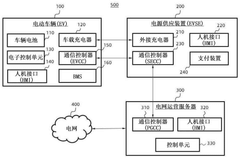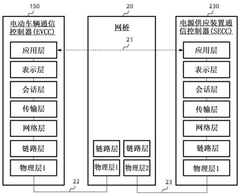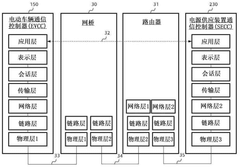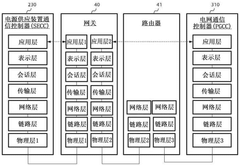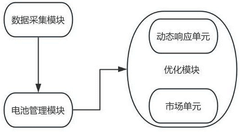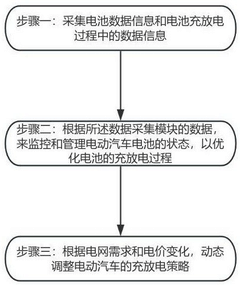The Role of V2G in Achieving Smart Grid Objectives
AUG 8, 20259 MIN READ
Generate Your Research Report Instantly with AI Agent
Patsnap Eureka helps you evaluate technical feasibility & market potential.
V2G Technology Evolution and Objectives
Vehicle-to-Grid (V2G) technology has evolved significantly over the past decade, playing an increasingly crucial role in achieving smart grid objectives. The concept of V2G emerged in the late 1990s, but it wasn't until the 2010s that it gained substantial traction due to advancements in electric vehicle (EV) technology and growing concerns about grid stability and renewable energy integration.
The primary objective of V2G technology is to transform EVs from mere consumers of electricity into active participants in the power grid. This bidirectional flow of energy allows EVs to charge during off-peak hours and discharge power back to the grid during peak demand periods. Such capability addresses several key smart grid objectives, including load balancing, grid stabilization, and the integration of intermittent renewable energy sources.
As V2G technology has progressed, its objectives have expanded beyond basic load shifting. Modern V2G systems aim to provide ancillary services to the grid, such as frequency regulation and voltage support. These services are critical for maintaining grid stability, especially as the penetration of renewable energy sources increases, introducing more variability into the power supply.
Another important objective of V2G technology is to create a more resilient and flexible grid infrastructure. By leveraging the distributed storage capacity of EVs, V2G systems can help mitigate the impact of power outages and reduce the need for expensive peaker plants. This aligns with the smart grid's goal of enhancing overall system reliability and efficiency.
The evolution of V2G technology has also been driven by the need to develop new business models and value streams for EV owners and utilities. Objectives now include the creation of energy markets where EV owners can participate and be compensated for providing grid services. This economic incentive is crucial for widespread adoption of V2G technology and the realization of its full potential in supporting smart grid objectives.
Recent technological advancements have focused on improving the efficiency and longevity of EV batteries when used in V2G applications. This addresses concerns about battery degradation and aims to make V2G more attractive to EV owners. Additionally, the development of smart charging algorithms and advanced power electronics has enhanced the precision and responsiveness of V2G systems, making them more effective in supporting grid operations.
Looking forward, the objectives of V2G technology are expanding to include its integration with other smart grid technologies, such as demand response systems and renewable energy forecasting. The goal is to create a holistic ecosystem where V2G plays a central role in balancing supply and demand, optimizing energy use, and facilitating the transition to a more sustainable and resilient power grid.
The primary objective of V2G technology is to transform EVs from mere consumers of electricity into active participants in the power grid. This bidirectional flow of energy allows EVs to charge during off-peak hours and discharge power back to the grid during peak demand periods. Such capability addresses several key smart grid objectives, including load balancing, grid stabilization, and the integration of intermittent renewable energy sources.
As V2G technology has progressed, its objectives have expanded beyond basic load shifting. Modern V2G systems aim to provide ancillary services to the grid, such as frequency regulation and voltage support. These services are critical for maintaining grid stability, especially as the penetration of renewable energy sources increases, introducing more variability into the power supply.
Another important objective of V2G technology is to create a more resilient and flexible grid infrastructure. By leveraging the distributed storage capacity of EVs, V2G systems can help mitigate the impact of power outages and reduce the need for expensive peaker plants. This aligns with the smart grid's goal of enhancing overall system reliability and efficiency.
The evolution of V2G technology has also been driven by the need to develop new business models and value streams for EV owners and utilities. Objectives now include the creation of energy markets where EV owners can participate and be compensated for providing grid services. This economic incentive is crucial for widespread adoption of V2G technology and the realization of its full potential in supporting smart grid objectives.
Recent technological advancements have focused on improving the efficiency and longevity of EV batteries when used in V2G applications. This addresses concerns about battery degradation and aims to make V2G more attractive to EV owners. Additionally, the development of smart charging algorithms and advanced power electronics has enhanced the precision and responsiveness of V2G systems, making them more effective in supporting grid operations.
Looking forward, the objectives of V2G technology are expanding to include its integration with other smart grid technologies, such as demand response systems and renewable energy forecasting. The goal is to create a holistic ecosystem where V2G plays a central role in balancing supply and demand, optimizing energy use, and facilitating the transition to a more sustainable and resilient power grid.
Smart Grid Market Demand Analysis
The smart grid market is experiencing significant growth driven by the increasing demand for efficient and reliable electricity distribution systems. As countries worldwide strive to modernize their power infrastructure, the smart grid market is projected to expand substantially in the coming years. This growth is fueled by several factors, including the need for improved energy efficiency, integration of renewable energy sources, and enhanced grid reliability.
One of the key drivers of smart grid market demand is the growing emphasis on energy conservation and sustainability. Governments and utilities are increasingly focused on reducing carbon emissions and improving overall energy efficiency. Smart grid technologies enable better monitoring and control of electricity consumption, allowing for more effective demand-side management and reduced energy waste. This aligns with global efforts to combat climate change and meet ambitious sustainability targets.
The integration of renewable energy sources into the power grid is another significant factor driving smart grid market demand. As the adoption of solar, wind, and other renewable technologies continues to rise, there is a growing need for advanced grid management systems that can handle the intermittent nature of these energy sources. Smart grids provide the necessary infrastructure to efficiently integrate and manage distributed energy resources, ensuring grid stability and reliability.
The increasing occurrence of power outages and the need for improved grid resilience are also contributing to the demand for smart grid solutions. Aging power infrastructure in many countries has led to more frequent blackouts and service disruptions. Smart grid technologies offer enhanced monitoring and self-healing capabilities, allowing utilities to quickly identify and respond to outages, minimizing downtime and improving overall service quality.
The rise of electric vehicles (EVs) is another factor driving smart grid market demand. As EV adoption increases, there is a growing need for intelligent charging infrastructure that can manage the additional load on the grid. Vehicle-to-Grid (V2G) technology, in particular, is gaining attention as a potential solution for grid balancing and energy storage. This technology allows EVs to not only draw power from the grid but also feed power back when needed, creating a more flexible and resilient energy system.
Urbanization and the development of smart cities are also contributing to the growth of the smart grid market. As cities become more connected and technologically advanced, there is an increasing demand for intelligent energy management systems that can optimize power distribution and consumption across various urban infrastructures, including buildings, transportation systems, and public services.
In conclusion, the smart grid market is poised for substantial growth, driven by the need for energy efficiency, renewable integration, grid reliability, and the evolving landscape of urban development and transportation. The role of V2G technology in achieving smart grid objectives is particularly significant, as it represents a promising solution for addressing many of the challenges faced by modern power systems.
One of the key drivers of smart grid market demand is the growing emphasis on energy conservation and sustainability. Governments and utilities are increasingly focused on reducing carbon emissions and improving overall energy efficiency. Smart grid technologies enable better monitoring and control of electricity consumption, allowing for more effective demand-side management and reduced energy waste. This aligns with global efforts to combat climate change and meet ambitious sustainability targets.
The integration of renewable energy sources into the power grid is another significant factor driving smart grid market demand. As the adoption of solar, wind, and other renewable technologies continues to rise, there is a growing need for advanced grid management systems that can handle the intermittent nature of these energy sources. Smart grids provide the necessary infrastructure to efficiently integrate and manage distributed energy resources, ensuring grid stability and reliability.
The increasing occurrence of power outages and the need for improved grid resilience are also contributing to the demand for smart grid solutions. Aging power infrastructure in many countries has led to more frequent blackouts and service disruptions. Smart grid technologies offer enhanced monitoring and self-healing capabilities, allowing utilities to quickly identify and respond to outages, minimizing downtime and improving overall service quality.
The rise of electric vehicles (EVs) is another factor driving smart grid market demand. As EV adoption increases, there is a growing need for intelligent charging infrastructure that can manage the additional load on the grid. Vehicle-to-Grid (V2G) technology, in particular, is gaining attention as a potential solution for grid balancing and energy storage. This technology allows EVs to not only draw power from the grid but also feed power back when needed, creating a more flexible and resilient energy system.
Urbanization and the development of smart cities are also contributing to the growth of the smart grid market. As cities become more connected and technologically advanced, there is an increasing demand for intelligent energy management systems that can optimize power distribution and consumption across various urban infrastructures, including buildings, transportation systems, and public services.
In conclusion, the smart grid market is poised for substantial growth, driven by the need for energy efficiency, renewable integration, grid reliability, and the evolving landscape of urban development and transportation. The role of V2G technology in achieving smart grid objectives is particularly significant, as it represents a promising solution for addressing many of the challenges faced by modern power systems.
V2G Integration Challenges
The integration of Vehicle-to-Grid (V2G) technology into smart grid systems presents several significant challenges that must be addressed for successful implementation. One of the primary obstacles is the development of robust and standardized communication protocols between electric vehicles (EVs) and the grid infrastructure. These protocols need to ensure seamless, secure, and real-time data exchange to facilitate efficient power flow management and grid stability.
Another critical challenge lies in the design and implementation of advanced power electronics and control systems. These components must be capable of managing bidirectional power flow between EVs and the grid while maintaining power quality and ensuring grid stability. The complexity of these systems increases when considering the diverse range of EV models and charging technologies in the market.
Grid infrastructure upgrades pose a substantial challenge for V2G integration. Many existing power distribution networks were not designed to accommodate the bidirectional power flow and increased load variability associated with V2G systems. Significant investments in grid modernization, including smart meters, advanced distribution management systems, and enhanced transformer capabilities, are necessary to support widespread V2G adoption.
The development of accurate forecasting and scheduling algorithms represents another hurdle in V2G integration. These algorithms must predict EV charging and discharging patterns, considering factors such as user behavior, energy prices, and grid conditions. The accuracy of these predictions is crucial for optimizing grid operations and maximizing the benefits of V2G technology.
Cybersecurity concerns present a significant challenge in V2G integration. The increased connectivity between EVs and the grid creates potential vulnerabilities that could be exploited by malicious actors. Robust security measures, including encryption protocols, authentication mechanisms, and intrusion detection systems, must be implemented to protect both the grid infrastructure and individual EV users from cyber threats.
Regulatory and policy frameworks pose additional challenges for V2G integration. Many existing regulations and market structures were not designed with V2G technology in mind, creating barriers to its widespread adoption. Policymakers and regulators must develop new frameworks that address issues such as energy market participation, grid services compensation, and liability concerns associated with V2G operations.
Finally, consumer acceptance and engagement represent a crucial challenge in V2G integration. Many EV owners may be hesitant to participate in V2G programs due to concerns about battery degradation, reduced vehicle availability, or complex pricing structures. Developing user-friendly interfaces, transparent incentive programs, and educational initiatives will be essential to overcome these barriers and encourage widespread participation in V2G systems.
Another critical challenge lies in the design and implementation of advanced power electronics and control systems. These components must be capable of managing bidirectional power flow between EVs and the grid while maintaining power quality and ensuring grid stability. The complexity of these systems increases when considering the diverse range of EV models and charging technologies in the market.
Grid infrastructure upgrades pose a substantial challenge for V2G integration. Many existing power distribution networks were not designed to accommodate the bidirectional power flow and increased load variability associated with V2G systems. Significant investments in grid modernization, including smart meters, advanced distribution management systems, and enhanced transformer capabilities, are necessary to support widespread V2G adoption.
The development of accurate forecasting and scheduling algorithms represents another hurdle in V2G integration. These algorithms must predict EV charging and discharging patterns, considering factors such as user behavior, energy prices, and grid conditions. The accuracy of these predictions is crucial for optimizing grid operations and maximizing the benefits of V2G technology.
Cybersecurity concerns present a significant challenge in V2G integration. The increased connectivity between EVs and the grid creates potential vulnerabilities that could be exploited by malicious actors. Robust security measures, including encryption protocols, authentication mechanisms, and intrusion detection systems, must be implemented to protect both the grid infrastructure and individual EV users from cyber threats.
Regulatory and policy frameworks pose additional challenges for V2G integration. Many existing regulations and market structures were not designed with V2G technology in mind, creating barriers to its widespread adoption. Policymakers and regulators must develop new frameworks that address issues such as energy market participation, grid services compensation, and liability concerns associated with V2G operations.
Finally, consumer acceptance and engagement represent a crucial challenge in V2G integration. Many EV owners may be hesitant to participate in V2G programs due to concerns about battery degradation, reduced vehicle availability, or complex pricing structures. Developing user-friendly interfaces, transparent incentive programs, and educational initiatives will be essential to overcome these barriers and encourage widespread participation in V2G systems.
Current V2G Implementation Strategies
01 Grid stability and load balancing
V2G technology aims to enhance grid stability and load balancing by utilizing electric vehicles as distributed energy resources. This allows for bidirectional power flow between vehicles and the grid, helping to smooth out demand peaks and fill in supply valleys. The system can respond to real-time grid conditions, providing frequency regulation and voltage support.- Grid stability and load balancing: V2G technology aims to enhance grid stability and load balancing by utilizing electric vehicles as distributed energy resources. This allows for bidirectional power flow between vehicles and the grid, helping to smooth out demand peaks and fill in supply valleys. The system can respond to real-time grid conditions, providing frequency regulation and voltage support.
- Renewable energy integration: V2G systems support the integration of renewable energy sources by providing storage capacity for excess energy generated during peak production periods. Electric vehicles can store this energy and feed it back to the grid when renewable sources are not producing, helping to balance the intermittent nature of renewable energy and increase overall grid efficiency.
- Energy cost optimization: V2G technology enables smart charging and discharging strategies to optimize energy costs for both vehicle owners and grid operators. By charging during off-peak hours and selling energy back to the grid during peak demand, V2G systems can reduce electricity costs and create new revenue streams for EV owners while helping utilities manage demand more efficiently.
- Grid resilience and emergency power supply: V2G systems can enhance grid resilience by providing backup power during outages or emergencies. Electric vehicles can serve as mobile energy storage units, supplying power to critical infrastructure or residential areas during blackouts, thus improving the overall reliability and security of the power grid.
- Smart grid communication and control: V2G technology incorporates advanced communication and control systems to enable seamless integration of electric vehicles with the smart grid. This includes real-time data exchange, predictive analytics, and automated decision-making processes to optimize power flow, manage charging schedules, and respond to grid conditions, ultimately creating a more efficient and flexible energy ecosystem.
02 Renewable energy integration
V2G systems support the integration of renewable energy sources by providing energy storage capabilities. Electric vehicles can store excess energy generated from intermittent renewable sources like solar and wind, and feed it back to the grid when needed. This helps to balance supply and demand, reducing the need for conventional power plants and promoting cleaner energy use.Expand Specific Solutions03 Energy cost optimization
V2G technology enables smart charging and discharging strategies to optimize energy costs for both vehicle owners and grid operators. By leveraging time-of-use pricing and demand response programs, the system can charge vehicles during off-peak hours and discharge during peak demand periods, reducing overall energy costs and improving grid efficiency.Expand Specific Solutions04 Enhanced grid resilience
V2G systems contribute to grid resilience by providing backup power during outages or emergencies. Electric vehicles can serve as mobile energy storage units, supplying power to critical infrastructure or residential areas during blackouts. This capability enhances the overall reliability and robustness of the smart grid.Expand Specific Solutions05 Advanced energy management and forecasting
V2G technology incorporates advanced energy management systems and forecasting algorithms to optimize grid operations. These systems analyze historical data, weather patterns, and user behavior to predict energy demand and supply, allowing for proactive grid management. This helps in reducing energy waste, improving overall system efficiency, and supporting the transition to a more sustainable energy ecosystem.Expand Specific Solutions
Key V2G Industry Players
The V2G (Vehicle-to-Grid) technology in smart grid implementation is in its early development stage, with a growing market potential as electric vehicle adoption increases. The market size is expanding, driven by the need for grid stability and renewable energy integration. Technologically, V2G is still evolving, with companies like Honda, Hyundai, and LG Electronics leading in research and development. State Grid Corporation of China and its subsidiaries are actively exploring V2G applications, while universities such as Shanghai Jiao Tong University contribute to advancing the technology. The competitive landscape is diverse, involving automakers, energy companies, and technology firms collaborating to overcome technical challenges and establish standardized V2G protocols.
State Grid Corp. of China
Technical Solution: State Grid Corp. of China has developed a comprehensive V2G (Vehicle-to-Grid) system to support smart grid objectives. Their approach integrates large-scale electric vehicle (EV) charging infrastructure with advanced power management systems. The company has implemented a network of smart charging stations capable of bidirectional power flow, allowing EVs to both draw power from and feed power back to the grid[1]. This system utilizes real-time data analytics and machine learning algorithms to optimize charging schedules based on grid demand, renewable energy availability, and EV user preferences[3]. State Grid has also developed a cloud-based platform that enables seamless communication between EVs, charging stations, and the grid, facilitating efficient load balancing and demand response mechanisms[5].
Strengths: Extensive grid infrastructure, advanced data analytics capabilities, and large-scale implementation experience. Weaknesses: Potential challenges in standardization across different EV manufacturers and the need for significant investment in upgrading existing grid infrastructure.
Huawei Technologies Co., Ltd.
Technical Solution: Huawei has developed an innovative V2G solution that leverages its expertise in 5G communication and IoT technologies. Their system incorporates high-speed, low-latency 5G networks to enable real-time communication between EVs and the grid[2]. Huawei's V2G platform utilizes edge computing to process data locally at charging stations, reducing latency and improving response times for grid balancing[4]. The company has also integrated AI-driven predictive analytics to forecast EV charging patterns and grid demand, enabling proactive load management[6]. Huawei's solution includes smart inverters that can dynamically adjust power flow based on grid conditions, maximizing the efficiency of energy transfer between EVs and the grid[8].
Strengths: Advanced communication technologies, AI-driven analytics, and seamless integration with smart city infrastructure. Weaknesses: Reliance on widespread 5G adoption and potential cybersecurity concerns due to increased connectivity.
V2G Core Innovations
Communication method and electric vehicle
PatentActiveCN114274837B
Innovation
- By exchanging charging plan-related messages between the communication controller in the electric vehicle, the power supply device, and the grid operation server, the charging fee is calculated and approved, an efficient payment policy established for the time period is established, and the information is provided to users participating in CO2 emission restrictions. Offer credits or rewards.
A dynamic regulation system and method for electric vehicles participating in power grid based on V2G technology
PatentActiveCN118651117B
Innovation
- The data acquisition module is used to monitor battery status. The battery management module dynamically adjusts the charge and discharge strategy based on comprehensive evaluation values and changes in electricity prices. The optimization module includes a dynamic response unit and a market unit, a predictive maintenance unit and a charge and discharge adjustment factor to achieve intelligent charge and discharge management and economy. excitation.
V2G Regulatory Framework
The regulatory framework for Vehicle-to-Grid (V2G) technology plays a crucial role in shaping its implementation and adoption within smart grid systems. As V2G represents a novel approach to energy management, existing regulations often require adaptation to accommodate this emerging technology.
At the national level, many countries are developing or updating their energy policies to include provisions for V2G integration. These policies typically address issues such as grid interconnection standards, metering requirements, and compensation mechanisms for V2G services. For instance, some nations have implemented feed-in tariffs or net metering schemes to incentivize V2G participation.
Regulatory bodies, such as public utility commissions, are tasked with establishing guidelines for V2G operations. These guidelines often cover technical specifications, safety standards, and operational protocols. They may also define the roles and responsibilities of various stakeholders, including vehicle owners, utilities, and aggregators.
One key aspect of the V2G regulatory framework is the development of standardized communication protocols. These protocols ensure interoperability between electric vehicles, charging infrastructure, and grid systems. Organizations like the Society of Automotive Engineers (SAE) and the International Electrotechnical Commission (IEC) have been instrumental in developing these standards.
Data privacy and cybersecurity regulations are also critical components of the V2G framework. As V2G systems involve the exchange of sensitive information, such as vehicle charging patterns and energy consumption data, robust measures must be in place to protect consumer privacy and prevent unauthorized access to the grid.
The regulatory landscape for V2G also encompasses market rules and structures. This includes defining how V2G services can participate in electricity markets, such as frequency regulation or demand response programs. Some jurisdictions have created specific market products tailored to V2G capabilities, while others have modified existing market structures to accommodate V2G resources.
Environmental regulations intersect with V2G frameworks as well. Many countries view V2G as a tool for reducing greenhouse gas emissions and supporting renewable energy integration. Consequently, regulations may include provisions that encourage V2G deployment as part of broader climate change mitigation strategies.
As V2G technology continues to evolve, regulatory frameworks must remain flexible and adaptable. Regular reviews and updates are necessary to ensure that regulations keep pace with technological advancements and changing market conditions. This ongoing process involves collaboration between policymakers, industry stakeholders, and research institutions to create a supportive environment for V2G implementation within smart grid systems.
At the national level, many countries are developing or updating their energy policies to include provisions for V2G integration. These policies typically address issues such as grid interconnection standards, metering requirements, and compensation mechanisms for V2G services. For instance, some nations have implemented feed-in tariffs or net metering schemes to incentivize V2G participation.
Regulatory bodies, such as public utility commissions, are tasked with establishing guidelines for V2G operations. These guidelines often cover technical specifications, safety standards, and operational protocols. They may also define the roles and responsibilities of various stakeholders, including vehicle owners, utilities, and aggregators.
One key aspect of the V2G regulatory framework is the development of standardized communication protocols. These protocols ensure interoperability between electric vehicles, charging infrastructure, and grid systems. Organizations like the Society of Automotive Engineers (SAE) and the International Electrotechnical Commission (IEC) have been instrumental in developing these standards.
Data privacy and cybersecurity regulations are also critical components of the V2G framework. As V2G systems involve the exchange of sensitive information, such as vehicle charging patterns and energy consumption data, robust measures must be in place to protect consumer privacy and prevent unauthorized access to the grid.
The regulatory landscape for V2G also encompasses market rules and structures. This includes defining how V2G services can participate in electricity markets, such as frequency regulation or demand response programs. Some jurisdictions have created specific market products tailored to V2G capabilities, while others have modified existing market structures to accommodate V2G resources.
Environmental regulations intersect with V2G frameworks as well. Many countries view V2G as a tool for reducing greenhouse gas emissions and supporting renewable energy integration. Consequently, regulations may include provisions that encourage V2G deployment as part of broader climate change mitigation strategies.
As V2G technology continues to evolve, regulatory frameworks must remain flexible and adaptable. Regular reviews and updates are necessary to ensure that regulations keep pace with technological advancements and changing market conditions. This ongoing process involves collaboration between policymakers, industry stakeholders, and research institutions to create a supportive environment for V2G implementation within smart grid systems.
V2G Environmental Impact
Vehicle-to-Grid (V2G) technology plays a crucial role in achieving smart grid objectives, and its environmental impact is a key consideration in its implementation. V2G systems enable bidirectional power flow between electric vehicles (EVs) and the grid, allowing EVs to serve as distributed energy storage units. This capability has significant implications for reducing greenhouse gas emissions and promoting sustainable energy practices.
One of the primary environmental benefits of V2G is its potential to increase the integration of renewable energy sources into the grid. By utilizing EVs as energy storage devices, V2G systems can help balance the intermittent nature of renewable energy generation, such as solar and wind power. This enhanced grid flexibility allows for a higher penetration of clean energy sources, reducing reliance on fossil fuels and lowering overall carbon emissions.
V2G technology also contributes to peak load reduction and grid stabilization. By enabling EVs to discharge power back to the grid during periods of high demand, V2G systems can help flatten the load curve and reduce the need for peaker plants, which are often less efficient and more polluting. This load-leveling effect can lead to a more efficient use of existing power generation resources, potentially reducing overall emissions from the electricity sector.
Furthermore, V2G implementation can extend the lifespan of EV batteries through optimized charging and discharging cycles. By managing the battery's state of charge more effectively, V2G systems can potentially reduce battery degradation, thereby decreasing the environmental impact associated with battery production and disposal. This aspect of V2G technology aligns with circular economy principles and supports sustainable resource management.
The widespread adoption of V2G technology may also indirectly contribute to increased EV adoption rates. As V2G systems provide additional value to EV owners through potential revenue streams and enhanced grid services, they may incentivize more consumers to switch to electric vehicles. This shift towards electrification in the transportation sector can lead to substantial reductions in tailpipe emissions and improve urban air quality.
However, it is important to consider the potential negative environmental impacts of V2G implementation. The increased cycling of EV batteries for grid services may lead to faster battery degradation in some cases, potentially offsetting some of the environmental benefits. Additionally, the production and installation of V2G infrastructure, including bidirectional chargers and communication systems, have their own environmental footprint that must be accounted for in lifecycle assessments.
In conclusion, while V2G technology offers significant potential for positive environmental impact through enhanced renewable energy integration, improved grid efficiency, and support for EV adoption, careful consideration must be given to its implementation to maximize benefits and minimize potential drawbacks. Ongoing research and pilot projects will be crucial in optimizing V2G systems for maximum environmental benefit within the context of smart grid objectives.
One of the primary environmental benefits of V2G is its potential to increase the integration of renewable energy sources into the grid. By utilizing EVs as energy storage devices, V2G systems can help balance the intermittent nature of renewable energy generation, such as solar and wind power. This enhanced grid flexibility allows for a higher penetration of clean energy sources, reducing reliance on fossil fuels and lowering overall carbon emissions.
V2G technology also contributes to peak load reduction and grid stabilization. By enabling EVs to discharge power back to the grid during periods of high demand, V2G systems can help flatten the load curve and reduce the need for peaker plants, which are often less efficient and more polluting. This load-leveling effect can lead to a more efficient use of existing power generation resources, potentially reducing overall emissions from the electricity sector.
Furthermore, V2G implementation can extend the lifespan of EV batteries through optimized charging and discharging cycles. By managing the battery's state of charge more effectively, V2G systems can potentially reduce battery degradation, thereby decreasing the environmental impact associated with battery production and disposal. This aspect of V2G technology aligns with circular economy principles and supports sustainable resource management.
The widespread adoption of V2G technology may also indirectly contribute to increased EV adoption rates. As V2G systems provide additional value to EV owners through potential revenue streams and enhanced grid services, they may incentivize more consumers to switch to electric vehicles. This shift towards electrification in the transportation sector can lead to substantial reductions in tailpipe emissions and improve urban air quality.
However, it is important to consider the potential negative environmental impacts of V2G implementation. The increased cycling of EV batteries for grid services may lead to faster battery degradation in some cases, potentially offsetting some of the environmental benefits. Additionally, the production and installation of V2G infrastructure, including bidirectional chargers and communication systems, have their own environmental footprint that must be accounted for in lifecycle assessments.
In conclusion, while V2G technology offers significant potential for positive environmental impact through enhanced renewable energy integration, improved grid efficiency, and support for EV adoption, careful consideration must be given to its implementation to maximize benefits and minimize potential drawbacks. Ongoing research and pilot projects will be crucial in optimizing V2G systems for maximum environmental benefit within the context of smart grid objectives.
Unlock deeper insights with Patsnap Eureka Quick Research — get a full tech report to explore trends and direct your research. Try now!
Generate Your Research Report Instantly with AI Agent
Supercharge your innovation with Patsnap Eureka AI Agent Platform!
